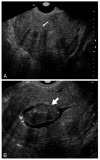Uterine leiomyomas: individualizing the approach to a heterogeneous condition
- PMID: 21252757
- PMCID: PMC3150866
- DOI: 10.1097/AOG.0b013e31820780e3
Uterine leiomyomas: individualizing the approach to a heterogeneous condition
Figures




Similar articles
-
Pathologic features of uterine leiomyomas following uterine artery embolization.Int J Gynecol Pathol. 2001 Oct;20(4):407-9. doi: 10.1097/00004347-200110000-00017. Int J Gynecol Pathol. 2001. PMID: 11603229 No abstract available.
-
[Uterine leiomyoma and fibroleiomyoma: treatment for non-pregnant women ].Akush Ginekol (Sofiia). 2015;54 Suppl 1:3-18. Akush Ginekol (Sofiia). 2015. PMID: 26137765 Bulgarian. No abstract available.
-
Development of a Model for the Prediction of Treatment Response of Uterine Leiomyomas after Uterine Artery Embolization.Int J Med Sci. 2018 Nov 23;15(14):1771-1777. doi: 10.7150/ijms.28687. eCollection 2018. Int J Med Sci. 2018. PMID: 30588202 Free PMC article.
-
Uterine Artery Embolization of Uterine Leiomyomas: Predictive MRI Features of Volumetric Response.AJR Am J Roentgenol. 2021 Apr;216(4):967-974. doi: 10.2214/AJR.20.22906. Epub 2021 Feb 17. AJR Am J Roentgenol. 2021. PMID: 33594913
-
Bleeding associated with uterine leiomyomas. Tailor treatment to the individual patient.Prescrire Int. 2014 May;23(149):130-5. Prescrire Int. 2014. PMID: 24926520 Review.
Cited by
-
Clinical predictors of successful magnetic resonance-guided focused ultrasound (MRgFUS) for uterine leiomyoma.J Ther Ultrasound. 2013 Sep 2;1:15. doi: 10.1186/2050-5736-1-15. eCollection 2013. J Ther Ultrasound. 2013. PMID: 25512860 Free PMC article.
-
Vaginal Pessary for Uterine Repositioning during High-Intensity Focused Ultrasound Ablation of Uterine Leiomyomas.Gynecol Obstet Invest. 2016;81(3):285-8. doi: 10.1159/000441782. Epub 2015 Nov 20. Gynecol Obstet Invest. 2016. PMID: 26584482 Free PMC article.
-
Comparative Effectiveness of Uterine Leiomyoma Procedures Using a Large Insurance Claims Database.Obstet Gynecol. 2017 Nov;130(5):1047-1056. doi: 10.1097/AOG.0000000000002331. Obstet Gynecol. 2017. PMID: 29016510 Free PMC article.
-
Biomechanical Forces Determine Fibroid Stem Cell Transformation and the Receptivity Status of the Endometrium: A Critical Appraisal.Int J Mol Sci. 2022 Nov 17;23(22):14201. doi: 10.3390/ijms232214201. Int J Mol Sci. 2022. PMID: 36430682 Free PMC article. Review.
-
Putative human myometrial and fibroid stem-like cells have mesenchymal stem cell and endometrial stromal cell properties.Hum Reprod. 2020 Jan 1;35(1):44-57. doi: 10.1093/humrep/dez247. Hum Reprod. 2020. PMID: 31913469 Free PMC article.
References
-
- Speert H. Obstetrics and gynecology in America: a history. Chicago (IL): American College of Obstetricians and Gynecologists; 1980.
-
- Farquhar CM, Steiner CA. Hysterectomy rates in the United States 1990–1997. Obstet Gynecol. 2002;99:229–34. - PubMed
-
- Jacobson GF, Shaber RE, Armstrong MA, Hung YY. Hysterectomy rates for benign indications. Obstet Gynecol. 2006;107:1278–83. - PubMed
-
- Merrill RM. Hysterectomy surveillance in the United States, 1997 through 2005. Med Sci Monit. 2008;14:CR24–31. - PubMed
-
- Day Baird D, Dunson DB, Hill MC, Cousins D, Schectman JM. High cumulative incidence of uterine leiomyoma in black and white women: ultrasound evidence. Am J Obstet Gynecol. 2003;188:100–7. - PubMed
Suggested Reading List
-
- Alternatives to hysterectomy in the management of leiomyomas. ACOG Practice Bulletin. American College of Obstetricians and Gynecologists. Obstet Gynecol. 2008;112:387–400. - PubMed
-
- Catherino WH, editor. Insights and advances in uterine leiomyomas. New York (NY): Thieme; 2010. - PubMed
-
- Goodwin SC, Spies JB. Uterine fibroid embolization. N Engl J Med. 2009;361:690–7. - PubMed
Publication types
MeSH terms
Grants and funding
LinkOut - more resources
Full Text Sources
Other Literature Sources
Medical

